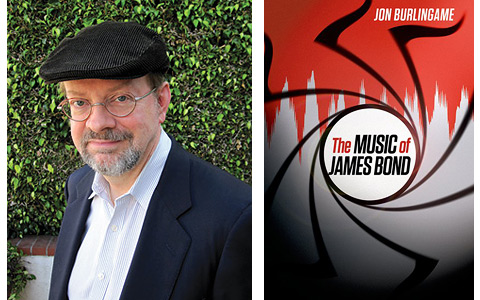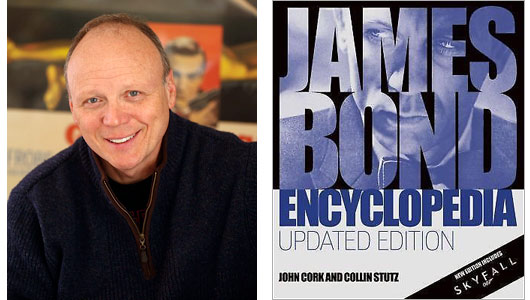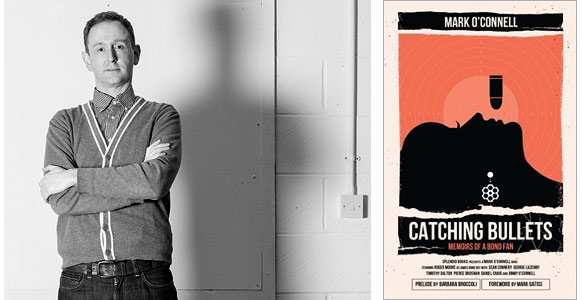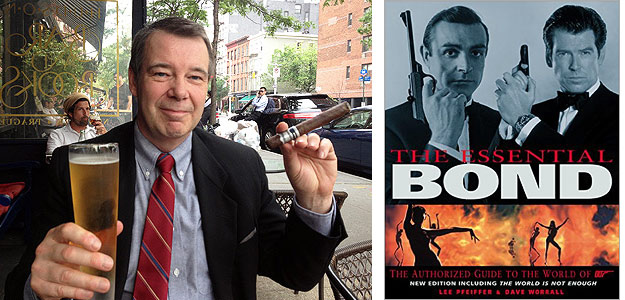“The Spy Who Loved Me was a celebration the moment it premiered. It’s not so much a movie or a story as it is a wondrous tour through the exotic, sexy, dangerous, and beautiful world of Roger Moore’s 007.” — 007 historian John Cork
The Digital Bits is pleased to present this retrospective commemorating the 40th anniversary of the release of The Spy Who Loved Me, the tenth (official) cinematic James Bond adventure and, arguably, the fan favorite of the Roger Moore era.
As with our previous 007 articles (see You Only Live Twice, Diamonds Are Forever, Casino Royale, For Your Eyes Only, Thunderball, GoldenEye, A View to a Kill, On Her Majesty’s Secret Service, Goldfinger, and 007… Fifty Years Strong), The Bits and History, Legacy & Showmanship continue the series with this retrospective featuring a Q&A with an esteemed group of James Bond scholars, documentarians and historians who discuss the virtues, shortcomings and legacy of The Spy Who Loved Me. [Read on here...]
The participants (in alphabetical order)…
Jon Burlingame is the author of The Music of James Bond (Oxford University Press, 2012). He also authored Sound and Vision: 60 Years of Motion Picture Soundtracks (Watson-Guptill, 2000) and TV’s Biggest Hits: The Story of Television Themes from Dragnet to Friends (Schirmer, 1996). He writes regularly for the entertainment industry trade Variety and has also been published in The Hollywood Reporter, Los Angeles Times, The New York Times, and The Washington Post. He started writing about spy music for the 1970s fanzine File Forty and has since produced seven CDs of original music from The Man from U.N.C.L.E. for the Film Score Monthly label. His website is www.jonburlingame.com.
John Cork is the author (with Collin Stutz) of James Bond Encyclopedia (DK, 2007) and (with Bruce Scivally) James Bond: The Legacy (Abrams, 2002) and (with Maryam d’Abo) Bond Girls Are Forever: The Women of James Bond (Abrams, 2003). He is the president of Cloverland, a multi-media production company, producing documentaries and supplemental material for movies on DVD and Blu-ray, including material for Chariots of Fire, The Hustler, and many of the James Bond and Pink Panther titles. Cork also wrote the screenplay to The Long Walk Home (1990), starring Whoopi Goldberg and Sissy Spacek. He wrote and directed the feature documentary You Belong to Me: Sex, Race and Murder on the Suwannee River for producers Jude Hagin and Hillary Saltzman (daughter of original Bond producer, Harry Saltzman). He has recently contributed articles on the literary history of James Bond for ianfleming.com and The Book Collector.
Mark O’Connell is a punditeer, the grandson of Bond producer Cubby Broccoli’s chauffeur, and the author of Catching Bullets: Memoirs of a Bond Fan (Splendid Books, 2012). His next book will be published this autumn.
Lee Pfeiffer is the author (with Dave Worrall) of The Essential Bond: The Authorized Guide to the World of 007 (Boxtree, 1998/Harper Collins, 1999) and (with Philip Lisa) of The Incredible World of 007: An Authorized Celebration of James Bond (Citadel, 1992). He also wrote The Films of Sean Connery (Citadel, 2001) and (with Michael Lewis) The Films of Harrison Ford (Citadel, 2002). Lee was a producer on the Goldfinger and Thunderball Special Edition LaserDisc sets and is the founder (with Dave Worrall) and Editor-in-Chief of Cinema Retro magazine, which celebrates films of the 1960s and 1970s and is “the Essential Guide to Cult and Classic Movies.”
Bruce Scivally is the author (with John Cork) of James Bond: The Legacy (Abrams, 2002). His other books include Superman on Film, Television, Radio & Broadway (McFarland, 2006), Billion Dollar Batman: A History of the Caped Crusader on Film, Radio and Television from 10¢ Comic Book to Global Icon (Henry Gray, 2011), Booze, Bullets & Broads: The Story of Matt Helm, Superspy of the Mad Men Era (Henry Gray, 2013) and Dracula FAQ: All That’s Left to Know About the Count from Transylvania (Backbeat, 2015). As well, he has written and produced numerous documentaries and featurettes that have appeared as supplemental material on LaserDisc, DVD and Blu-ray Disc, including several of the Charlie Chan, James Bond, and Pink Panther releases. He is Vice President of New Dimension Media in Chicago, Illinois.
The interviews were conducted separately and have been edited into a “roundtable” conversation format.
And now that the participants have been introduced, might I suggest preparing a martini (shaken, not stirred, of course) and cueing up the soundtrack album to The Spy Who Loved Me, and then enjoy the conversation with these James Bond authorities.
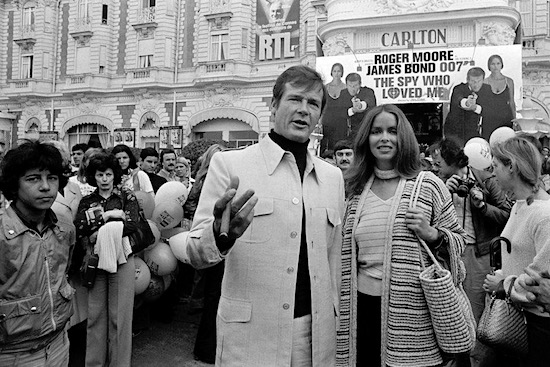
Michael Coate (The Digital Bits): In what way is The Spy Who Loved Me worthy of celebration on its 40th anniversary?
Jon Burlingame: This was the third of the Roger Moore Bonds, and in my view the best-realized of the three. Much at the time was made of the “equal status” of Moore’s 007 and Barbara Bach’s Anya, his Soviet counterpart. And while they inevitably ended up in bed together, they were very much spy-versus-spy on an equivalent footing for much of the film. Even Bob Peak’s brilliant key art placed Anya and Bond back-to-back, with Anya on the left, strongly implying that this was not just a “Bond girl” but a woman who could be 007’s match.
The plot was an improvement — a supertanker swallowing nuclear submarines, not a voodoo blaxploitation story or a paid assassin trying to kill Bond — and demanded a gigantic new stage, conceived by production designer Ken Adam to contain his larger-than-life ideas. Pinewood’s new 007 Stage was the result, and it was showcased in dynamite fashion in the film. And, for me as Bond’s resident music historian, it’s hugely important for the song Nobody Does It Better, which reached Number Two on the charts, won an Oscar nomination and became one of the most iconic songs in the history of the Bond franchise.
This was the first of the Bond films to be produced solely by Albert R. Broccoli, following the departure of his longtime partner Harry Saltzman. And it was the first Bond movie to use the title but no characters or storyline from the original novel (although the films had been getting farther and farther away from Ian Fleming’s plotlines anyway).
John Cork: The Spy Who Loved Me was a celebration the moment it premiered. It’s not so much a movie or a story as it is a wondrous tour through the exotic, sexy, dangerous, and beautiful world of Roger Moore’s 007. Just as Goldfinger, the third Connery film, was a celebration of what made Sean Connery’s Bond so appealing, The Spy Who Loved Me, the third Moore film, is a celebration of everything that makes Roger Moore a great James Bond. From the snowy peaks to the ocean depths, from the ancient pyramids to the modern nuclear submarines, the mix is just right. Amazingly, it was a film born out of complete and utter chaos. This is a film that works because of the key ingredient that makes the James Bond films so fantastic: collaboration. There are the obvious names that contributed so much. Let’s start with Ken Adam. Of all his sets, the Liparus interior is the greatest. I remember the sounds of audience members gasping when the lights blasted on. But all the sets are just so perfect. The title song is iconic, Carly Simon’s voice sends chills down my spine every time I hear it. Marvin Hamlish’s score is perfect for the film. John Glenn and his crew, working with Rick Sylvester captured the greatest stunt in film history in a shot that has every viewer holding their breath. Second Unit Director Ernie Day did masterful work. The helicopter/Lotus chase was his. Derek Meddings did his best model work for Spy. How good? They originally had permission to shoot a real Shell tanker for free, but the insurance was still too expensive. They still invited the folks from Shell to the premiere, and they wanted to know what company loaned them a supertanker for filming. They didn’t know it was a model! Willy Bogner was back shooting the skiing. That great shot going under the ice bridge still works. Lamar Boren was back with the underwater unit in the Bahamas. But there were other names few are likely to know. Robin Browne, an amazing cameraman with a brilliant eye shot so much of the effects work. Gordon MacCallum did the mix, and no Bond film has ever sounded better.
Mark O’Connell: Bond ‘77 totally warrants celebration. Of course, the sad and recent passing of Roger Moore and the rapid fire tribute screenings of this film which were held across the land have put it under a timely spotlight again. Fate celebrated this film before film fans could, but either way — when most Bond fans of any standing have to pick a Roger Moore Bond film this is the one. It doesn’t have to be everyone’s favorite but the audiences know this was the one that re-ignited the onscreen Bond juggernaut and it is often the Roger Moore Bond film.
Lee Pfeiffer: The Spy Who Loved Me was a very significant film in the Bond canon. After The Man with the Golden Gun was released in 1974, producers Cubby Broccoli and Harry Saltzman saw their partnership break up when Saltzman had to divest his shares of the Bond series in order to pay off mounting personal debt. There was bad will because he never offered Cubby an opportunity to buy his shares and own the franchise outright. Instead, he sold his half of the Bond series directly to United Artists, thus tying Cubby to the studio as his new partner. This made the acrimonious relationship between Cubby and Harry even worse. Not helping matters was the fact that The Man with the Golden Gun — Roger Moore’s second screen outing as 007 — did not perform as well as expected at the box office. The film’s emphasis on slapstick humor combined with the worst script of the series led some to wonder if the Bond films were in danger of going out of style. Cubby realized he had to make a bold move to bring Bond back in dramatic fashion. Instead of rushing into production, he painstakingly made plans to adapt The Spy Who Loved Me for the screen. It would be two-and-a-half years before the film would hit theaters — a rather lengthy gap in those days. Fleming had detested his own source novel, which was a bizarre, stagnant tale set mostly in enclosed rooms and lacking the larger-than-life villains and locations his books were known for. Thus, Fleming insisted in his contract with the producers that only the title could be used for a future film, not any of the novel’s elements. Cubby seemed to realize he had one more shot to make the Bond franchise reinvigorated — and to prove he could do so without Harry Saltzman. United Artists pulled out all the stops and granted the film the biggest budget of the series to date. The film enjoyed unusually strong reviews and became a box office sensation, allowing Roger Moore to prove that he was indeed a successful Bond in his own right.
Bruce Scivally: The Spy Who Loved Me is the film in which Roger Moore really came into his own as James Bond. Moore’s previous 007 director, Guy Hamilton, tried to balance his natural gift for witty bon mots with an edge of Connery-esque toughness (like slapping Andrea Anders and threatening to break her arm in The Man with the Golden Gun). Lewis Gilbert, on the other hand, simply let Moore be Moore, a kind of Cary Grant-lite who looked great in a tux, and didn’t seem to be taking any of the proceedings very seriously, letting us all in on the joke and giving us permission to simply enjoy it and go along for the ride. As a result, Moore recast 007 in his image — a Bond more suave and debonair than Sean Connery’s, less feral and threatening than Connery’s, but still able to make audiences believe that a tricked-out car could do incredible things at the push of a button. Two films later, Moore would again reinvent the character, returning to a slightly tougher portrayal, but after The Spy Who Loved Me his Bond would always have a twinkle in his eye that seemed to say, “Yes, it’s outlandish, but go with it. Have fun. I am.” And yes, even on first viewing, I recognized that the plot of The Spy Who Loved Me was basically a retread of Lewis Gilbert’s earlier Bond opus, You Only Live Twice, except Spy had more action and less travelogue — and a 007 who actually seemed to be enjoying himself.

Coate: Can you describe what it was like seeing The Spy Who Loved Me for the first time?
Burlingame: I vividly remember thrilling to the pre-credit sequence, with composer Marvin Hamlisch’s ultra-modern, synth-laden, Bond Theme adaptation for the spectacular stunt, as Bond skis off the side of the mountain. The music stops (for a full 20 seconds!) and then bursts into the screaming-brass Bond Theme midsection as 007’s Union Jack-adorned parachute opens. Then, of course, we cut to the opening titles and our first exposure to Carly Simon singing Nobody Does It Better — again, one of the great all-time Bond themes.
I rarely use the word “awesome” (I’m way out of that demographic) but I remember thinking Ken Adam’s production designs on this film were awesome. From Stromberg’s giant sea fortress Atlantis to the car/submarine Lotus Esprit, everything was eye-popping. The locations — from Egypt to Sardinia — were stunning in Claude Renoir’s cinematography, and while Hamlisch’s score isn’t to everyone’s taste, it was certainly a fresh take on Bond music at the time; and Paul Buckmaster’s Mujaba Club music was pretty hip in 1977.
Cork: I was 15. My grandfather had set me up with a summer trip to Europe in 1977. I knew The Spy Who Loved Me was coming out, and I even found Eon Productions’ address and mailed them asking how to get premiere tickets. They sent me the brochure and would have sold me tickets, but the tour wasn’t going to be in London on 7/7/77, the premiere date. About 10 days later I arrived, and that night, I went to the Odeon Leicester Square, bought tickets to both the evening show and the late show. I had never been in a movie theater like the Odeon. I had never heard surround sound before. I remember jumping when I heard explosions behind me in the cinema! It was one of the greatest film-going experiences of my life. Little can describe the way that audience reacted. I remember walking down Piccadilly toward Hyde Park in the middle of the night after having seen the film twice, the banners for the Queen’s Silver Jubilee handing from light posts, the streets all but empty, replaying the film in my mind.
O’Connell: I caught it on an ailing VHS copy found by chance in the bottom of a bargain basement bin being suffocated by a Pink Panther or two and what Emmanuelle film had come out to rent that month. It was a bit like finally getting that landmark Beatles album where you already loved a lot of the tracks but hadn’t experienced them in their context. The parachute jump, the Lotus dive, the Studio 54 wet-bike arrival, Gogol and his phone-call day-wear, Stromberg, the risqué blue titles not hiding everything of a flesh-based nature and some of the killer lines were already part of the Greatest Hits of Bond movies. I knew what a lot of the heralded ingredients were. But now I could see them in the way the Eon chefs wanted.
Pfeiffer: I was in college and had just come back from a whirlwind tour around Europe and Africa for a month. I was happy that my return to America coincided with the opening of the film. I saw it in a New Jersey theater where they had a Lotus Esprit on display, though I’m still not sure if it was the one seen in the film. Like most Bond fans, I breathed a sigh of relief. After Golden Gun, Bond finally had his mojo back.
Scivally: I earned my driver’s license in the spring of 1977, so this was the first James Bond film that I saw in a theater. By then, I’d been introduced to 007 through the telecasts of the films on ABC-TV, and loved them. It’s hard to appreciate the impact those movies had in the 1960s and 70s, when they were the apotheosis of action films, with eye-popping stunts and exotic locations, and featuring some of the most fetching beauties in cinema. The Spy Who Loved Me had all that, and something different — the humor that had always been an undertone of the films became an overtone with The Spy Who Loved Me, a change that befit Roger Moore. From the eye-popping pre-credits ski stunt to Bond “keeping the British end up,” this 007 fired on all cylinders from start to finish. As a 16-year-old, I absolutely loved it; as a 56-year-old, the 16-year-old in me still revels in it.
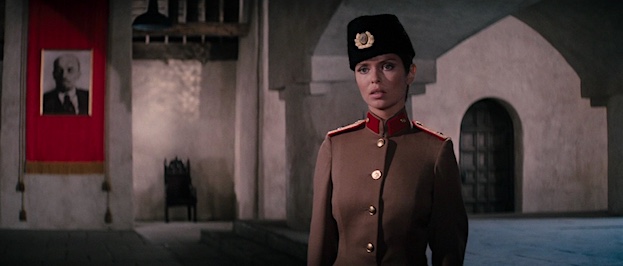
Coate: In what way was Curt Jurgens’ Karl Stromberg a memorable villain?
Burlingame: Jurgens was a formidable screen presence, in the aftermath of his performances as German officers in The Enemy Below, The Longest Day and Battle of Britain, so he brought a gravitas to Stromberg that was different than the distinguished, elitist tone of Christopher Lee (in The Man With the Golden Gun) and the ruthless, mostly disgusted attitude of Yaphet Kotto (in Live and Let Die).
Cork: Jurgens is a great actor, and I love that Stromberg is a “brain” villain, elegant, evil, far from the physical threat to Bond, yet, somehow more dangerous for it. A good “brain” villain will have you on what you think is the President’s jet, or sitting down at his dinner table because he’s clearly defenseless. Jurgens knows how to appear larger-than-life in every shot, and that made him perfect for those amazing Ken Adam sets.
Of course, we have to mention Richard Kiel. Second best henchman of the series behind Oddjob. Lewis Gilbert’s cameraman, Claude Renoir, knew how to photograph Kiel and really work shots to have fun with his height and size. That was missing in Moonraker. Renoir gets grief because his eyes were slowly failing during shooting, but he was very important to the visuals of Spy. Watch his films and he knows where to place the camera to help tell the story.
Okay, time for absurd Curt Jurgens trivia! He holds the distinction (as best as I can tell) of appearing in more films with other Bond villain actors than any other Bond villain actor! He’s in movies with Robert Shaw, Walter Gotell (a villain in From Russia with Love), Gert Frobe, Luciana Paluzzi, Telly Savalas, Steven Berkoff, Orson Welles (yes, I count the 1967 Casino Royale), and, wait for it, Christoph Waltz. He’s also in movies with the top names in 60s spy culture: Sean Connery, Richard Burton (The Spy Who Came in from the Cold), James Coburn, Robert Culp, Peter Graves, and even almost-Bond, John Gavin!
O’Connell: He certainly works two of the mainstays of Bond villainy — being sat at a table or standing menacingly with both hands behind your back. Curt Jurgens is a fascinating European actor who doesn’t struggle at conveying duplicitous charm. Yet for me Stromberg is one of the more passive, less beguiling Bond adversaries. The villainy of the character is achieved via other means — particularly Ken Adam’s pointed production design suggesting the wealth and vision, but also the loneliness of the man as well as the spider web of villainy is summed up by that black, hulking arachnid of a base, Atlantis. The real villainy of The Spy Who Loved Me is achieved by the trail of sub-villains. The might and dangerous intentions of Stromberg are not conveyed through Jurgens, but rather Jaws, Naomi and the gang passing on that story baton of a microfilm. I always suggest that a good Bond foe is merely Bond himself gone wrong. Michael Lonsdale’s Drax in the following Moonraker does that societal one-upmanship and powerplay with more of a delicious, ruthless streak. It is also not clear why a life under the sea is so endearing to Stromberg. And Bond gets no real confrontation with the villain here. Shooting under a table over a light lunch of salad leaves is not the same as being inflated by air, set on fire or sucked out into space.
Pfeiffer: Curt Jurgens was an exceptionally good actor, internationally respected. He had known Cubby, who respected his talents. The knock against Jurgens at the time was that he was a bit old and too sedate to pose a significant menace to Bond, but I always defended his presence in the film. Even if the role of Stromberg was somewhat under-written, his scenes opposite Roger Moore are very enjoyable. Stromberg isn’t one of the more memorable, world-class villains, but Jurgens’ presence in a Bond movie is quite satisfying.
Scivally: Best known for playing military commanders and barons, Curt Jurgens had an imperial presence, but he played Stromberg with a dignified, regal reserve that seemed out of step with the rest of the film’s performances, making him seem dull by comparison. Rather than an out-sized megalomaniac taking great glee in his villainy, Jurgens seemed more like a corporate bureaucrat who, if he weren’t going to kill Bond, would sell him shares in Atlantis. In previous 007 films, the henchman was often colorful, but never more so than the villain; in Spy, Jurgens’ Stromberg is totally upstaged by Jaws, a steel-toothed killer who is initially terrifying but becomes increasingly comedic as the film progresses, somehow managing to be both menacing and endearing at the same time. When Jaws plops into the shark tank, we want him to bite that shark and live to terrorize 007 again; by contrast, when Oddjob was electrocuted, we were relieved that the seemingly indestructible strongman was finally stone cold dead.
Coate: In what way was Barbara Bach’s Anya Amasova a memorable Bond Girl?
Burlingame: And that’s the point: She was a Bond Girl but not a Bond Girl. Anya was a highly trained, highly capable and thoroughly untrustworthy (shades of Putin!) KGB agent. She and 007 must join forces but remain wary of one another. As an actress, Barbara Bach was no Diana Rigg or Eva Green, but in that era the look and the style was pretty important. I daresay this is her best-remembered film (she made Caveman and married Ringo Starr in 1981).
Cork: There is a strange silkiness to Bach’s Anya that really fits the film. I love her in the movie, but, and this is going to sound so, so wrong, if late in the movie her face got hit and a faceplate fell off revealing Stepford Wife robot workings inside, I would have thought, “Oh, of course she was a robot! It all makes sense now!” That sing-song voice, those weird little delays before she reacts to dialogue, think about it the next time you watch the film. There is an undeniable fembot quality. That moment when she bumps into Bond wandering around the columns of Luxor and spins around in karate mode, sees it’s Bond, then drop out of that program and into the next, watch that. That is not an actress playing a Russian spy. That’s an actress brilliantly playing a robot playing a Russian spy. Whatever you want to think, that performance works like gangbusters. It is perfect for the film.
O’Connell: The role of Amasova is key as it heralds a new era of more equal-minded Bond women. All intents and purposes clearly were to really challenge 007 and his professional world and for the most part, Bach’s icy cold and very still performance works. She certainly made an impact on a lot of male Bond fans at the time, and it wasn’t just the Lotus Esprit’s buttons she knew how to press. Anya also affords Moore one of his starkest, least expected beats of Bond and that is when he is faced with the murder of Amasova’s lover. His line about being a spy and on a job is brilliantly and pointedly delivered and reminds that Moore’s Bond always had a serious core in the role.
Pfeiffer: Barbara Bach was one of the most stunning beauties to ever grace a Bond movie. Her acting skills were somewhat limited, to put it charitably, but she represented the key ingredients of a Bond heroine: courageous, resourceful and intelligent. There is a myth in some quarters that Bond women were all gorgeous airheads, but for the most part, this was not the case. They were very independent, quick thinking characters who were able to contribute mightily to thwarting the villains’ capers. It’s safe to say that Bond needed them as much as they needed Bond. Bach made such an eye-popping appearance, especially in the provocative outfits she wore in the film, that I recall John Simon, the ordinarily grumpy film critic for New York Magazine, salivating over her in his review as though he was a teenage boy ogling his teacher.
Scivally: While Barbara Bach would never give Meryl Streep a run for her money as a dramatic actress, her acting chops were adequate enough for The Spy Who Loved Me, and with her doe eyes and pouty lips, she was quite a looker, with a smashing figure, which is about all Bond movies of the period required of their leading ladies. The character was memorable for the series making its first nod to 70s feminism by attempting to portray a female equivalent to Bond — though Anya still needs 007 to rescue her from Stromberg in the end. She’s a character I’d like to have seen return; it should have been her and not General Gogol coming to collect the ATAC at the end of For Your Eyes Only, or sharing a hot tub with Bond in A View to a Kill.




